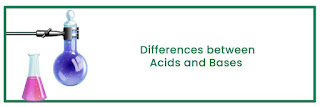Differences between acids and bases - NCERT Class 7 Science
Acids are a type of substance that includes hydrogen ions and can donate these ions to another substance.
Acidic compounds have a sour tang to them.
A substance that can accept hydrogen ions from acid is called a base. Caustic soda (NaOH) and caustic potash (KOH) are two examples.
Acids vs Bases
Acids
- Meaning of Acid - Acids are a substance that contains hydrogen ions and are capable of donating these hydrogen ions to another substance.
- Acid Impact on Litmus -Turns blue litmus red.
- Acid Taste - Sour
- Acid Ph Value - Less than 7
- Acid Chemical Composition - Acids always start with the chemical formula H. For example, HCL. However, organic acids are a notable exceptiont to this.
- Examples of Acid - Lactic, citric, and tartaric acid etc.
Bases
- Meaning of Bases - Bases are a substance that can accept hydrogen ions from an acid.
- Bases Impact on Litmus -Turns red litmus blue.
- Bases Taste - Bitter
- Bases Ph Value - Less than 7
- Bases Chemical Composition - Bases have a chemical formula OH at the end of it. For example- NaOH.
- Examples of Bases -Sodium hydroxide, Potassium hydroxide, etc.
Click to know Types of acid and Acid-base reactions.
Tag - what is acid; what is base; acid and base; examples of acid; examples of the base; NCERT Class 7 science; school online class

Comments
Post a Comment
Thank you we will contact ASAP.